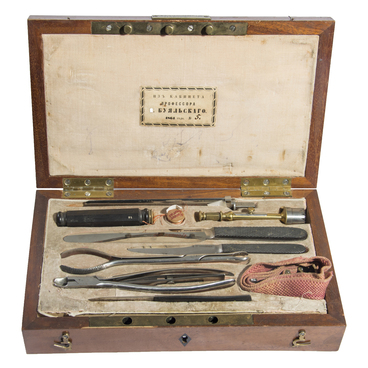The collection of the Military Medical Museum contains a sculpture of a military doctor in a winter uniform that was worn during the Patriotic War of 1812.
In the early 19th century, the uniform of a Russian military doctor consisted of a dark green single-breasted dress jacket without epaulets, a vest and breeches made of white cloth. The cuffs of the sleeves, the collar and the lining of the coattails of the dress jacket were decorated with red cloth welt. For the campaign, each doctor was given a dark green frock coat with silver buttons and a gray greatcoat with green welt. Doctors also wore jackboots with spurs, a sword and an officer’s bicorn hat. However, the doctor’s headdress did not have an officer’s plume — a thick bunch of cock feathers.
Russian military doctors contributed a lot to the defeat of Napoleon’s army. Their job was hard. During and after the battle, soldiers picked up the wounded, put them on stretchers and brought them to a field hospital or to a dressing station. There, the surgeon examined the wounds with a special probe — he looked for bullets, buckshot, and bone fragments. Then the surgeon extracted foreign bodies and scraps of uniform, stopped the bleeding, and sutured the wound with a waxed thread. He put lint with camphor or mercury on top of the wound, they were considered to have a soothing and anti-inflammatory effect.
Lint is a dressing material made ‘by unraveling clean, thin and soft cloth’. Lint was a substitute for medical cotton wool. Also, doctors used band-aids, dressing, and bandages.
In case of severe extremity injuries, surgeons oftentimes performed amputations. By the time the surgery began, the wound shock had worn off, and the pain intensified. Before the amputation, the patients were given vodka — this was an attempt to somehow help the wounded.
Ilya Radozhitsky describes a surgical operation during the 1812 campaign in his ‘Travel Records of an Artilleryman’, published in 1835:
In the early 19th century, the uniform of a Russian military doctor consisted of a dark green single-breasted dress jacket without epaulets, a vest and breeches made of white cloth. The cuffs of the sleeves, the collar and the lining of the coattails of the dress jacket were decorated with red cloth welt. For the campaign, each doctor was given a dark green frock coat with silver buttons and a gray greatcoat with green welt. Doctors also wore jackboots with spurs, a sword and an officer’s bicorn hat. However, the doctor’s headdress did not have an officer’s plume — a thick bunch of cock feathers.
Russian military doctors contributed a lot to the defeat of Napoleon’s army. Their job was hard. During and after the battle, soldiers picked up the wounded, put them on stretchers and brought them to a field hospital or to a dressing station. There, the surgeon examined the wounds with a special probe — he looked for bullets, buckshot, and bone fragments. Then the surgeon extracted foreign bodies and scraps of uniform, stopped the bleeding, and sutured the wound with a waxed thread. He put lint with camphor or mercury on top of the wound, they were considered to have a soothing and anti-inflammatory effect.
Lint is a dressing material made ‘by unraveling clean, thin and soft cloth’. Lint was a substitute for medical cotton wool. Also, doctors used band-aids, dressing, and bandages.
In case of severe extremity injuries, surgeons oftentimes performed amputations. By the time the surgery began, the wound shock had worn off, and the pain intensified. Before the amputation, the patients were given vodka — this was an attempt to somehow help the wounded.
Ilya Radozhitsky describes a surgical operation during the 1812 campaign in his ‘Travel Records of an Artilleryman’, published in 1835:



